Kuršų kišenė/tvirtovė II WW2
Kuršo kišenė arba Kuršo tvirtovė arba Kuršo katilas (latv. Kurzemes katls, Kurzemes cietoksnis, vok. Kurland-Kessel, Kurland-Festung; rus. Курляндский котёл, блокада Курляндспкой projektuoja theвкокогрондспкой) Kuržemės ir iš dalies Žiemgalos regionų teritorija, kur per Antrąjį pasaulinį karą, nuo 1944 m. spalio mėn. iki 1945 m. gegužės mėn., Vokietijos armijų grupė „Šiaurė“, vėliau pervadinta į Kuržemės armijų grupę, buvo atkirsta 1-ojo ir 2-ojo Raudonosios armijos Baltijos frontų.
Kuršų kišenė ir Kuršo tvirtovė Antrojo pasaulinio karo metais buvo naudojamos propagandos tikslais.
Jūsų komentarai
Susijusios vietos
Saldaus vokiečių kareivių kapinės
Saldaus vokiečių kareivių kapinės yra prie Saldaus–Ežerės plento. Kapinėse, užimančiose 8 hektarų plotą, yra apie 25 000 vokiečių kareivių, taip pat kai kurių Latvijos legionierių palaikai. Perlaidojimai vyksta nuo 1997 m.
Nuo gegužės 1 d. iki spalio 1 d. memorialiniame kambaryje galima apžiūrėti parodą apie Kuršo mūšius. Šiuo laikotarpiu memorialinis kambarys dirba darbo dienomis nuo 9:00 iki 17:00 val., o šeštadieniais ir sekmadieniais kapinėse dirba ir gidas. Taip pat galima susipažinti su Saldaus vokiečių kareivių kapinėse palaidotų ir visoje Latvijoje žuvusių kareivių sąrašais.
Privati karinių daiktų ir siuvimo mašinų kolekcija
Vienintelė Latvijoje siuvimo mašinų kolekcija, kurioje yra daugiau nei 200 skirtingų siuvimo mašinų iš ikikario ir sovietmečio laikotarpio, kurios atliko tiesioginį vaidmenį karinės aprangos gamyboje ikikario ir karo metais. Kolekcijos kūrėjas - Juris Beloivansas.
Soviet soldiers' cemetery "Tuški"
The fraternal cemetery of the Red Army 130th Latvian and 8th Estonian Rifle Corps soldiers is located about 350 metres south-west of the Blīdene-Remte road. The name derives from the farm Tušķi, which was located 400 m south of the cemetery.
On 17 March 1945, the last attempt of the Red Army in Kurzeme began. The 308th Latvian Rifle Division attacked south-west and west of the Tušķi homestead and during three days of fighting crossed the Blīdene-Remte road in the 142.2 area of the highlands and reached the Jaunāsmuižas-Mezmali line. The soldiers killed during the battles were buried in several small cemeteries near Ķēķiai, Vērotāji, Jaunāsmuiža and elsewhere.
In the late 1960s, when the Soviet Union began to commemorate the Second World War, a new cemetery was established north of the ruins of the Tušķu homestead, where it was planned to rebury all the soldiers who had fallen in the Pilsblidene and Kaulači area. In reality, the reburial was partial, as very often the fallen soldiers remained in their original gravesites, but only their names were overwritten in the cemetery of the Tuški brothers. The names of the soldiers of the 8th Estonian Rifle Corps, whose main wartime cemetery was located on the site of the present Pilsblidene cemetery, can also be found in the Tuški Brethren Cemetery.
There is also a monument to Jakob Kundera, a soldier of the 8th Estonian Rifle Corps, to whom the object 'Kundera dots' is dedicated. Immediately after the battle, Jakob Kundera was buried in what is now Pilsblidene Cemetery, and later reburied in the Tuški Brethren Cemetery.
Rebuilt German army dugouts in Melnsils Campsite
Campsite Melnsils is located next to the sea 10 km from Kolka. Here German Army type dugouts have been built that can be used as lodging for the night. This is a nod to the history of this region when during World War II the German Army had a border guard post and a camp site here and soldiers built dugouts for themselves using materials that could be found nearby. Trenches can still be found in the dunes along the coast.
‘Bunker Nr. 13’ is the largest of the two dugouts, with three bunk beds. The ‘Small Bunker’ is smaller and has two bunk beds. Campsite ‘Melnsils’ is a great choice for active recreation and sporting events for up to 300 people. It is located near the Slitere National Park, coastal bluffs and forest hiking trails. There are marked cycling trails that wind through the natural surroundings in the area. There are designated places for tents and campfires by the sea, as well as barrel-type guest houses for two or four people. A bathhouse with different types of whisks is also available.
Vaiņode station
The railway station building was opened with the construction of the Liepāja-Vainode railway line in 1871. The station building itself was opened in 1872. This was also the beginning of a great activity in the development of the central streets of Vaiņode. It is significant that in the guidebooks of the time, the distance of each building or object was indicated as the distance from the railway station. The railway station was once an important military transport hub.
During the First World War, a branch line was built from the station to the airfield, which brought materials (metal shapes for hangars), cranes, winches and ammunition for war stores, which were then transported by zeppelins to Riga and bombed the Russian fortifications.
The railway station building was not affected by the devastation of World War II and has not changed its appearance over time. Vaiņode station can be seen from the outside.
The military activity in the vicinity of Vaiņode can be traced back to the successful Red Army offensive that began on 5 October 1944 in the vicinity of Šiauliai. Quickly crushing the weak German resistance, Soviet tank units were tasked with seizing the strategically important Liepāja-Shaul railway line. In the early hours of 9 October 1944, the first units of the 79th Tank Brigade of the 19th Panzer Corps and the separate units of the 143rd Tank Brigade launched an offensive. As a result of the collapse of the German front, only small units of the German 61st Infantry Division, supported by armoured trains, were present in the eastern outskirts of Vaiņode. The resistance was quickly overcome and by the evening of 9 October the whole of Vaiņode was under the complete control of the Red Army. On 10 October, units of the 103rd Rifle Corps of the Soviet 6th Guards Army arrived and continued their attacks, pushing back the German 61st Infantry Division 2 km north of the Skaistkalne sanatorium. As the Soviet forces took Vaiņode with little fighting, the Vaiņode station and the town's buildings suffered relatively little.
The fighting got a little closer to Vaiņode on 24 October 1944, when the German 10th Corps, with the 14th Panzer Division in the lead, carried out an offensive operation nicknamed "Eberhard". During the fighting, the front line consolidated just north of the sanatorium and remained there until 27 October, when the Red Army launched an offensive known as the 1st Kurland Bolshoi.
Pilsbidenės dvaras
Dvaro rūmai buvo pastatyti klasicistinio stiliaus XIX a. 3-ajame dešimtmetyje. Po žemės reformos dvaro kompleksas buvo nuomojamas privatiems asmenims, tačiau nuo 1932 m. atiteko Liaudies gerovės ministerijai.
6. Per įnirtingus Didžiojo Kuršo mūšio mūšius jis buvo naudojamas ir kaip atramos postas, ir kaip ligoninė.
1945 m. kovo 17 d. prasidėjo paskutinis Raudonosios armijos bandymas pulti Kuršą. Vokiečių 24-osios pėstininkų divizijos daliniai gynėsi Pilsblīdenės dvaro komplekso apylinkėse. 1945 m. kovo 18 dvarą iš pietų puolė 43-iosios gvardijos Latvijos šaulių divizijos 121-asis šaulių pulkas, tačiau nesėkmingai. Iš vakarų puolė 7-osios Estijos šaulių divizijos 300-ojo šaulių pulko 1-asis batalionas, o dienos pabaigoje 3-iojo gvardijos mechanizuotojo korpuso 35-oji tankų brigada Blīdenės-Remtės kelyje prisijungė prie 249-osios Estijos šaulių divizijos 917-ojo šaulių pulko 1-ojo bataliono.
Kovo 19-osios naktį 19-osios Latvijos SS Grenadierių divizijos 43-iasis Grenadierių pulkas atvyko į Blīdenės stoties apylinkes ir kontratakavo, siekdamas atsiimti Pilsblīdenės dvaro gyvenamąjį pastatą. Tačiau po naktinės tankų atakos stotyje įsitvirtino Raudonosios armijos estų ir latvių daliniai.
1959 m. pilyje kilo gaisras. Nuo 1961 iki 1986 m. gyvenamajame pastate veikė senelių namai. 1986 m. pilį vėl sunaikino gaisras. Nuo to laiko pilis stovi tuščia ir apgriuvusi.
Dvaro rūmus supa 24 hektarų parkas, kuris dabar apaugęs. Parke yra apie 37 nevietinių medžių ir krūmų rūšių plantacijos, jis yra saugomas valstybės. Parkas neprižiūrimas, o aplinka apaugusi.
Ezerės kraštotyros saugykla „Muitas Nams“
Ezerės muitinė yra Ezerėje, netoli Saldaus-Mažeikių plento, Latvijos ir Lietuvos pasienyje. 1945 m. gegužės 8 d. šiame pastate buvo pasirašytas vadinamojoje „Kuršo kišenėje“ apsuptų Vokietijos armijos dalinių „Kurzeme“ (Kurlandas) kapituliacijos aktas. Manoma, kad Antrasis pasaulinis karas iš tikrųjų baigėsi Ezerėje. Muitinėje yra ekspozicija, kurioje aprašomi Antrojo pasaulinio karo pabaigos įvykiai, ir eksponatai, kuriuose išsamiai aprašoma Ezerės parapijos istorija nuo seniausių laikų iki šių dienų. 1945 m. gegužės 7 d. rytą Leningrado fronto vadas maršalas L. Govorovas išsiuntė armijų grupės „Kurzeme“ vadovybei ultimatumą sudėti ginklus. Kapituliacijos aktą susijusios šalys pasirašė gegužės 8 d., jame išsamiai aprašyta perdavimo tvarka, ginklų surinkimo punktai, pateiktini dokumentai ir informacija bei kitos praktinės priemonės.
Priekulės karių kapinių memorialinis ansamblis
Priekulės karių kapinių memorialinis ansamblis yra Liepojos-Priekulės-Skodos kelyje ir yra didžiausia Antrojo pasaulinio karo sovietų karių laidojimo vieta Baltijos šalyse. Čia palaidota daugiau nei 23 000 sovietų karių. Operacija „Priekulė“ buvo vienas įnirtingiausių mūšių Kuržemės tvirtovėje, vykęs nuo 1944 m. spalio iki 1945 m. vasario 21 d. Priekulės mūšis 1945 m. vasarį truko septynias dienas ir naktis be perstojo ir pareikalavo daug aukų abiejose pusėse. Iki Priekulės karių kapinių pavertimo memorialu čia buvo pastatytas paskutinis iškilaus latvių skulptoriaus K. Zālės (1888–1942) paminklas, skirtas Alojos nepriklausomybės kovoms atminti. Nuo 1974 iki 1984 m. 8 ha Priekulės karių kapinės buvo paverstos memorialiniu ansambliu, skirtu Antrojo pasaulinio karo žuvusiems. Jį suprojektavo skulptorius P. Zaļkalne, architektai A. Zoldners ir E. Salguss bei dendrologas A. Lasis.
Memorialo centre stovi 12 m aukščio statula, vadinama „Tėvyne“, o žuvusiųjų vardai iškalti granito plokštėse. Iki Latvijos nepriklausomybės atgavimo Pergalės diena buvo plačiai švenčiama kasmet gegužės 9 d.
Pelči Manor
The Pelči Manor is located in Pelči parish, Kuldīga municipality. Tours of the manor house must be booked in advance. The Pelči Manor was built between 1903 and 1904, and this work by architect Wilhelm Neumann is one of the most outstanding manors of the early 20th century in Latvia. Its architectural language involves compositional principles and elements from Renaissance, Baroque and Art Nouveau. Between the late 19th century and 1920, the manor was owned by the Fürst von Lieven family.
From 1944 to 1945, the Pelči Manor was used as headquarters of the German Army Group ‘North’ (known as Army Group ‘Kurzeme’ as of 25 January 1945).
The headquarters of the Army Group ‘North’ moved from Sigulda to the Pelči Manor on 23 September 1944 in view of the planned retreat of the 18th army force from Estonia. The headquarters remained there approximately until mid-May 1945 when, after the capitulation of Army Group ‘Kurzeme’, information and documents were handed over to Red Army officers.
Barn of Nygrande Manor
The Nīgrande Local History Repository is located in the Nīgrande village in the manor barn, next to the Nīgrande Primary School, and is accessible by appointment.
The military history section of the repository includes an exhibition on World War II and original objects and parts found in the area after the war and in later years. You can also find out stories and see photographs about Nygrande and its surroundings from the War of Independence, World War II and the post-war period, as well as life on the collective farm in Soviet times.
The exhibition has a special place for the local writer Jēkab Janševskis and his works, and there is an exhibition presenting traditional manor house life and furnishings. A mammoth tusk found in Nīgrande is also on display in the barn of Nīgrande Manor.
Zlēku Tragedy Memorial Site
The memorial is located near the Zlēki Manor ensemble, in the western part of Karātavkalns. Around twenty boulders with the names of the people killed form a circle, and in the centre is a black marble obelisk about three metres high.
Some of those killed have been reburied at the Zlēki memorial.
In December 1944, in the vicinity of Zlēki, the German Nazi army carried out a large-scale operation against the civilian population.In the combat action log of Army Group Nord, an entry was made at 17.30 on 9 December 1944 that 161 people belonging to the "Rubens Brigade and units of the Red Arrow" had been killed on the enemy side during the action. In Soviet times, this figure was apparently taken as the total number of victims of the Zlēki tragedy, referring to civilians killed.
The course of the action is partly documented in the report of the head of the counter-intelligence section of the German 16th Army of 31 December 1944. It explains that from 5 to 9 December, under the leadership of the highest SS and police leader in Ostland, SS Oberruppenführer and Police General Friedrich Jekeln, a large-scale operation took place at Eichensumpf ("Oak Swamp") against the "Red Arrows" and the remnants of General Kurel's group at Abava.
Boat trip in Ciecere lake by the boat “Zezer”
During the ride with the recreational boat “Zezer” along Lake Ciecere near Brocēni you can listen to the audio guide and captain's stories about Lake Ciecere and the city of Brocēni on its shores, World War II events near Lake Ciecere, trenches on both sides of the lake and the Oak Island, as well as the tank route running along an observation tower and the tank that is said to be sunk in the lake. The audio guide is available in Latvian, Lithuanian, English, and Russian languages. The ride takes 1 hour 15 min.
Memorial sign for refugees "Sail of Hope" in Jūrkalne
The "Sail of Hope" commemorative sign for the World War II refugees who crossed the Baltic Sea by boat to the island of Gotland in Sweden in 1944 and 1945. The memorial is located in Osvalki on the dunes between the sea and Ventspils-Liepaja highway, near the public transport stop "Kaijas". It was created by sculptor Ģirts Burvis, who realised it as a sail of hope symbolising the memory of Latvian refugees.
Between autumn 1944 and spring 1945, fearing the renewed Soviet occupation but unwilling to evacuate to a devastated and threatened Germany, some Latvian citizens tried to reach the nearest neutral country, Sweden, by sea. Some of the boats were organised by the Latvian Central Council with the help of the Western Allied countries, which resulted in one of the largest refugee concentration points in Jūrkalnes parish. Besides the boats organised by the Latvian Central Council, other boats were also taken across the sea. It is estimated that about 5000 persons managed to cross the sea. The number of deaths is unknown, as no records were kept of refugees leaving the Kurzeme coast.
The voyages were dangerous because the refugees were threatened by German patrols on the coast and at sea, sea mines, Soviet aircraft and warships, as well as storms, as the crossings often took place in unsuitable and overloaded cutters and boats without sufficient fuel and food supplies, sea charts and navigational instruments. Departures from Latvia were carried out in secret. The destination of the boats was the island of Gotland, and the journeys most often started on the west coast of Courland (from Jūrkalne to Gotland is 90 nautical miles or about 170 kilometres as the crow flies).
Raudonosios armijos karių memorialinė vieta „Pieta“ Nykracės savivaldybėje
Sovietinių karių kapinės yra Skrundos–Embutės–Priekulės kelyje, aukštumoje tarp dviejų upių – Dzeldos pietuose ir Kojos šiaurėje. Jose palaidota daugiau nei 3000 žuvusiųjų.
Antrojo pasaulinio karo mūšiai
Raudonoji armija pradėjo puolimo operaciją nuo 1944 m. spalio 27 d., dabar žinomą kaip 1-asis Kurlando batalionas, kurios tikslas buvo sunaikinti vokiečių armijų grupę „Šiaurė“, vėliau pervadintą „Kurlandu“. Iki lapkričio 5 d. sovietų 61-oji armija ir dalys 6-osios gvardijos armijos bei 4-osios smūginės armijos pasiekė Zeldo upę, o kai kurie 5-osios gvardijos tankų armijos daliniai užėmė tiltų galvutes šiauriniame upės krante. Prieš kitą puolimą 1-ojo Baltijos fronto 2-oji gvardijos armija buvo perkelta į šį sektorių, kad pasiektų Skrundos-Liepojos geležinkelio liniją. Įvykdžius pradinę invaziją, puolimą Kuldygos link tęsė 5-oji gvardijos tankų armija.
Antrojo Kuršo mūšio pradžią atidėjo oro sąlygos ir jis prasidėjo tik lapkričio 19 d. Didžiausius pasiekimus Raudonoji armija pasiekė netoli dabartinių Brolių kapinių, o iki lapkričio 24 d. vakaro 1-asis ir 60-asis šaulių korpusai užėmė plakadarmą šiauriniame Koj upės krante. Tačiau Raudonosios armijos sėkmė tuo ir baigėsi. Vokiečių armijų grupė „Šiaurė“ numatė sovietų atakų kryptį ir čia sutelkė atitinkamas pajėgas, įskaitant dvi tankų divizijas.
1944 m. lapkričio 26 d. vakarą Raudonosios armijos atakos buvo sustabdytos ir iki Antrojo pasaulinio karo pabaigos nebuvo bandoma sunaikinti vokiečių pajėgų Kurše. Vėlesniuose mūšiuose buvo siekiama užkirsti kelią vokiečių armijos evakuacijai iš Kuršo.
Monument to the 8th Estonian Rifle Corps of the Red Army
The monument to the soldiers of the 8th Estonian Rifle Corps of the Red Army is located at the ruins of the Kaulači half-manor farmhouse about 100 metres south-west of the road.
On 17 March 1945, the last Red Army offensive attempt in Courland began. The task of the 7th Estonian Rifle Division of the 8th Estonian Rifle Corps was to reach the Riga-Liepaja railway line west of Blidene station and to secure the attack of the 3rd Guards Mechanised Corps in the direction of Gaiki. By the evening of 17 March, the 354th Rifle Regiment reached the railway south of Kaulači half-manor through the forest and continued its attacks north-westwards, reaching the Pikuliai houses. In the Kaulači semi-mansion and further to the north-east were the German Burg-Stellung positions, defended by individual units of the 329th Infantry Division. Throughout the day of 18 March, attacks by the 354th Rifle Regiment continued unsuccessfully.
On the evening of 18 March the 354th Rifle Regiment was relieved by the 27th Rifle Regiment. The advance unit of the 7th Mechanised Brigade of the 3rd Guards Mechanised Corps, the 1st Motorised Battalion, with one tank company, was also to be used for the attack. By the evening of 19 March, in a concentrated attack, the Soviets had captured the Kaulači half-manor, seizing a section of the German-built defensive line on the dominant high ground.
Until the end of March 1945, attacks by the 8th Estonian Rifle Corps and the 3rd Mechanised Corps in the directions of Vikstraute and Remte continued, but without success.
During the fighting, the Kaulači half-manor housed various levels of headquarters and a memorial stone was unveiled on the site in May 1975.
Collection of old cars "Retroknifiņš"
There is also a private collection in Zvārde municipality that contains both cars and trucks, as well as motorcycles.
The collection includes a restored German army BMW motorcycle, which was already here during the siege of the german army group "Kurland", as well as several German cars that remained here after the surrender of the German army group "Kurland".
This collection was created by enthusiast Jānis Dobelis. If you make an appointment in advance, the owner is ready to welcome you and give you a full description of each of the exhibits.
Horseback riding and horse riding tours around Paplaka and Priekule
The thematic horse-drawn carriage tours offered by the owner of the Stiebriņi farm, such as a horse-drawn carriage ride on a railway embankment, listening to a guide talk about the industrial heritage, are a great adventure. A horse-drawn carriage ride through the sites of the former military garrisons/towns around Paplaka will also be unforgettable. We particularly recommend the children's playground of the Soviet army housing estate, known locally as "Disneyland", the Finnish cottages (a Finnish wartime contribution to the Soviet Union), the water towers and the ruins of the former luxurious buildings of Barons fon Korfs.
German army coastguard searchlight site in Usi and border guard post in Kolka
No military infrastructure was planned in Cape Kolka, except for several offshore lighthouses that were rebuilt over a long period of time, either before World War I, during World War I or during World War II. Coastal defence batteries were planned for the narrowest part of the Irbe Strait, between the Sirves Peninsula and the Michael Tower Lighthouse.
The only fortifications of a military nature appeared at the end of 1944, when the German Army Group North was preparing to repel possible landings by the Soviet Baltic Fleet. In the spring of 1945, after the ice retreated, two batteries of the 532nd Artillery Division defended the coast at Cape Kolka. Battery 7 with four 75 mm guns and three 20 mm zenith guns. Battery 8 with four 88 mm mortars, three 20 mm mortars and an 81 mm mortar. The anti-deserter infantry garrison consisted of one of the most famous coastal defence units of the German Navy, the 5th Company of the 531st Artillery Division. Although it was an artillery unit by name, it was an infantry unit by deployment, which started its war in June 1941 at Liepāja. The unit was then garrisoned on islands in the Gulf of Finland and later took part in the fighting on the island of Saaremaa. The remnants of the division were reformed into one company and, reinforced with seven anti-tank guns and three 20 mm anti-aircraft guns, deployed at Cape Kolka.
The Soviet naval landing operation never took place and the German units capitulated in May 1945.
The military infrastructure in Cape Kolka began to be built after the Second World War, when Soviet border guard posts were deployed here and Kolka, like the entire Kurzeme coast from Mērsrags to the Lithuanian border, became a closed zone
German Army concrete tower (by the beach)
Walking along the slope of Mount Odju for 200 m along the path, you can see several objects related to the First World War - old concrete foundations of cannons from. An unfinished concrete observation tower stands next to the beach, parallel to the forest path along the Rojas Trail. The exact use of this object is unknown. Below the base, niches have been built for ammunition. Deep pits, former dugouts, are also visible among the pines.
Some of the objects probably date back to the end of the Second World War, when German coastal defence batteries were stationed in the area. The 4th Battery, 532nd Artillery Division, Navy, was armed with four 88 mm guns, three 37 mm guns, one 20 mm four-barrelled gun and one 50 mm mortar for illumination at night. Two 45 mm anti-tank guns are deployed at the mouth of the Rojas. The town garrison consisted of units of the 64th and 109th Sapper Battalions.
Ruins of Ķērkliņu church
The ruins of the Ķerkliņu Church are located about 5 kilometres north-west of Kokmuiža, near the Ķerkliņu Lake. The church was built in 1641 by Heinrich von Dönhoff (Derkarth), the owner of the Ķerkliņi manor. The original wooden church was replaced by a stone building, under which tombs were built for the dead of the Dönhof and later Kleist families. The tombs were already destroyed during the 1905 riots, but in 1949 the coffins were moved from the tombs to the church. The church was an example of the Kurzeme Baroque style - its carvings were made by the Kuldīga - Liepāja woodcarvers. Although the owners of the manor and the church were at various times plagued by financial problems, the church underwent several reconstructions during its existence. It also suffered during the First World War, after which the parish rebuilt the stonework in 1929 and added an organ in 1934. Unfortunately, the church was damaged during the Second World War and much of it was lost, so it is to be commended that before the church was rebuilt in 1933, many unique pieces of Baroque sculpture were photographed, inventoried and even ended up in the archives of the Monuments Board. With the establishment of the landfill and the eviction of the inhabitants, the church was never restored. Today, the church walls and tower are visible.
Virga manor antiquities storage
A storage room for antiques has been arranged in the house of the lords of the Virga manor. Here you can get an idea of who lived on the banks of the Vārtajas River and in Virga, as well as the Virga estate and the Nold family of barons, as well as the times of World War II and the Soviet kolkhoz in Virga. You can only look at the objects, but you can also listen to stories about topics that are interesting to visitors.
The Virga manor survived the Battle of the Kurzeme cauldron in 1944/1945 so well that a simple walk through the territory of the former manor allows you to perceive the breath of antiquity and the presence of the former inhabitants of the manor. A moment of rest at the "Karlias Zabaks" memorial of the Swedish king Charles XII or at a specially designed resting place near the Virga Tradition House will be useful not only for relaxation, but also as a reminder that Charles XII spent the winter of 1701 right here - in Virga.
In the former granary of the manor, now in the house of cultural and domestic traditions of local residents, you can rent a sauna and rooms for celebrations, including weddings.
Pampali church and the walls of the destroyed house
Pampāļi is a settlement in Pampāļu parish of Saldus county, the center of the parish is on the banks of Zaņas and its tributary Abrupe, 27 km from the county center Saldus and 147 km from Riga. The settlement was formed around the center of Pampāli manor after the agrarian reform. In 1933, Pampālis was granted the status of a densely populated place.
The hostilities on the outskirts of the Pampali began on November 21, 1944, when the Soviet 4th shock army, forcing Venta, began an attack in the direction of Saldus. By November 24, the situation stabilized and the front line remained unchanged until December 21.
On December 21, 1944, the so-called 3rd Battle of Kurzeme began, during which the 4th shock army of the 1st Baltic Front with 4 rifle corps (12 rifle divisions) and the 3rd Guards Mechanized Corps attacked in the direction of Saldus to connect there with the 2nd Baltic Front units. The German 132nd Infantry Division, whose 1st Battalion of the 436th Grenadier Regiment had fortified itself in the vicinity of the manor and the church, was defending itself in the Pampali district.
The attack on Pampāliai was carried out under the support of massive artillery fire by the 357th and 145th Rifle Divisions of the 1st Rifle Corps, supported by the 39th Guards Tank Brigade. During the first 24 hours of the battle, the Pampali garrison, commanded by the commander of the 14th (Anti-Tank) Company of the 436th Grenadier Regiment, Captain Eberard Coll, was encircled and virtually destroyed in fierce fighting.
Since Pampali was located right on the front line, all the buildings were hit by artillery fire and practically have not been preserved today.
Privati karinė kolekcija Mundigcieme
Privati karinė kolekcija Mundigcieme. Aivaras Ormanis ne vienerius metus kolekcionuoja istorinius objektus – karines uniformas, uniformas, kamufliažas, ryšio priemones, buities daiktus, apsaugos priemones iš skirtingų laikotarpių ir šalių, siekiančias Antrojo pasaulinio karo, sovietų kariuomenės ir nepriklausomos Latvijos atkūrimo laikų.
Kolekcija šiuo metu nėra gerai prižiūrima, o eksponatai saugomi buvusiame kolūkio tvarte.
Hermanno Faulo atminimo vieta
Jis įsikūręs kaimo kelių sankryžoje, nukrypus nuo kelio, vedančio iš Pienavos į Džūkstę.
Paminklas H. Faului ir devyniems vokiečių bei latvių kareiviams, žuvusiems 1944 m. gruodžio 27 d. mūšyje (tikriausiai susprogdinus juos tiesiogiai pataikius patrankos sviediniui) ir nuo to laiko laikomi dingusiais be žinios, nes nerasta jokių jų palaikų, dokumentų ar kitų tapatybės įrodymų.
Otanki Antiquities Store
The Otanki local museum is located in the yard of the former Rude school.
The guide's narration about the bunker and its creators, their further fate. A model of the bunker created by the students of the former Rude school (according to the partisans' own narrative) and a spatial map of the forest area of those times with marked houses of supporters and contacts can be viewed. Bunker household exhibits collected.
Advance application by phone 26323014 or email lelde.jagmina@gmail.com.
Evidence of the 2nd World War in Aizvikai Park
Aizvīkai Manor Park is located in Aizvīki, Gramzda Parish, just a few kilometers from the Lithuanian border.
The places of bunkers and trenches from the 2nd World War are still clearly visible in Aivvikai Park. One of the types of weapons was the Katyusha rocket launch system. Several such Rocket Launching Systems were located in Aizvīki Park, even after the end of the 2nd World War, and these places (caponieri) are clearly visible in nature.
This unique forest park, shrouded in secrets and legends, was created at the end of the 19th century as the Aizvīkai Manor Park, when the baron of the manor von Korff covered the nearby hilly land with a pine and spruce forest. Later, walking paths were laid on the 40 ha area, trees of other species were also planted and a pheasant garden was established.
In addition to the picturesque forest landscapes, there are also fairy-tale and fairy-tale figures made of wood, as well as stone sculptures, which tell travelers about events from the history of Aizvīkai and mark the cultural and historical places in the park. A Green Class has also been created in the park.
In order to get to know the cultural and historical heritage of Aizvīkai Manor Park more fully, we recommend using the services of a guide.
Bunker of the Red Army and caponiers in Aizvīkai Park
Aizvīkai Manor Park is located in Aizvīki, Gramzda Parish, just a few kilometers from the Lithuanian border.
The places of bunkers and trenches from the 2nd World War are still clearly visible in Aivvikai Park. The Red Army bunker has been restored in the park.
One of the types of weapons during World War II was the "Katyusha" rocket launch system. Several such Rocket Launching Systems were located in Aizvīki Park, even now these places (caponieri) are clearly visible in nature.
In order to get to know the cultural and historical heritage of Aizvīkai Manor Park more fully, we recommend using the services of a guide.
Memorial to the artillery regiment of Major J. Ozola
A memorial sign has been installed for the division of Major Jānis Ozolas on the side of the Riga - Liepāja highway, in Džukste parish, about one kilometer from the Kurzeme backwaters of the memorial site.
During the Third Battle of Kurzeme on December 31, Ozola's III Division and Major Kristaps Insberg's II Division as the last line of defense repulsed the enemy's overwhelming attack, preventing the front from breaking. In this battle, Ozol displays personal heroism and commanding ability
Jānis Ozols (1904-1947) was an officer of the Latvian Army and the Latvian Legion, a recipient of the Army's list of honor buckle, as well as a national partisan and a victim of Soviet repression.
Monument to the paramedics of Ruben's battalion
Ārija Stiebriņa and Velta Vaska, paramedics of the Rubeņa battalion, were reburied in the Cirkale cemetery, who were shot by German Nazi army units on December 9, 1944, together with other residents, deserters, etc. captured in the vicinity of Zlēki.
According to the stories, it follows that the young women have joined Ruben's battalion voluntarily. Together with Ruben's battalion, they went from Suntaži to Usma. However, during the Jekelna campaign, the young women were arrested on the road, taken to the forester's house in Vēlogi for questioning and shot together with a small group of other detainees. A woman, a resident of Cirkale, knew Arya and managed to rebury the remains of both girls at the edge of the Cirkale cemetery and took care of this cemetery throughout the Soviet occupation.
Under the leadership of SS-Obergruppenführer and General of Police Friedrich Jäckeln, head of the German 16th Army's counter-intelligence division, the top SS and police chief in Ostland, a large-scale operation took place in the Eichensumpf ("Oak Swamp") from December 5 to 9, which was directed against the "Red Arrow" and General The remnants of the Kurelis group near Abava.
The progress of the action is partially documented in the report of December 31, 1944.
Graves of soldiers of Ruben's battalion
The graves of soldiers of Ruben's battalion are located by the highway Kuldīga - Sabile. A road sign and a stone with the inscription "For Your Land and Freedom" are located just a few hundred meters from the road.
The battalion of Lieutenant Robert Rubenis was one of the parts of the military unit formed by General Jānis Kurelis, which did not surrender to the German troops and showed fierce German resistance. During the Usma period, the numerical composition of the battalion increased to 650 men with four fully equipped companies, an ambulance and a farm team. Commanding staff: lieutenant R. Rubenis, lieutenant Filipsons, vv A. Druviņš, vv Šults, vv Briedis, vv. sergeant J. Rubenis, J. Bergs, vv Jaunzems.
From November 14 to December 9, 1944, fierce battles took place in the parishes of Ugāle, Usma, Renda and Zlēki between units of the German 16th Army, SD and SS units under the command of police general Friedrich Jekeln and a separate battalion of the Kurelian unit commanded by lieutenant Roberts Rubenis. Around 250 German soldiers were killed in the battles near Renda and Zleki, while the losses of the Rubenes were around 50 people.
After the death of Lieutenant Rubenis, Druviņš announced to his men that he would continue to work on a voluntary basis and as a result, several dozen men made the decision to separate from Rubenis' battalion. On November 20-21, 1944, a group of 11 people was captured by a German SD unit and after interrogations they took them to the local forest and shot them.
Liepāja coastal artillery battery No. 2
Among the many objects of Liepāja Karosta, Liepāja coastal artillery battery No. 2 is still the most mysterious place in Liepaja. In battery no. 2, the ammunition depots of the troops of the various existing powers were always installed.
Liepaja Fortress Battery No. 2 was built further from the coastline and was protected by a high rampart. The batteries were armed with 16 11-inch (280 mm) mortars of the 1877 model. After the fortress was dismantled, ammunition warehouses were set up here. Due to the danger of explosions, the territory was closed to the public and guarded for 130 years, but now there is an exposition about the activities of the 1st Kurzeme Division Headquarters in the years 1919-1940s, as well as photo evidence of the 1st Liepāja Infantry Regiment, the 2nd Ventspils Infantry Regiment and the Kurzeme Artillery. regiment.
The coast of Mazirbe, from where the refugee boat traffic to Sweden took place in 1944
The coast of Mazirbe was an important place in the Second World War, from where the traffic of refugee boats to Sweden took place in 1944.
Staldzene steep bank, from which refugee boats to Sweden were transported in 1944
In 1944, there was an active traffic of refugee boats to the shores of Sweden from Staldzene.
The building in Ventspils, where LCP liaison Valentine Jaunzeme (Lasmane) lived in 1944
House at Lauku Street 4, Ventspils, where the teacher teacher Valentīne Lasmane (b. Jaunzeme) (1916–2018) lived and worked, who in 1944-1945 worked as LCP liaison and member of Ventspils communication group. Lived in Sweden after World War II. She compiled the testimonies of 130 boat refugees in the publication "Across the Sea 1944/1945." (Stockholm, 1990), but V. Lasmane's own life story can be read in the book "The night is not just for sleeping" (Riga, 2020). In 2000, she was awarded the Order of Three Stars. Died at the age of 102 in 2018 in the Stockholm suburb of Tebia.
The building in Ventspils, where in 1944-1945 In 2010, LCP representative and refugee boat traffic organizer Dr. lived in Kurzeme. Valdemars Ginters
House at 4 Katrīnes Street, Ventspils, where archaeologist Valdemārs Ęinters worked.
From October 1944 to May 8, 1945, the representative of the LCP in Kurzeme was archaeologist Valdemārs Ęinters (nicknames "Doctor", "Gardener") (1899–1979). Participant of the Latvian War of Independence, director of the State Historical Museum and docent of the University of Latvia. Awarded the Order of the Lāčplēš War and the Order of the Three Stars. One of the signatories of the LCP memorandum of March 17, 1944. Lived in Sweden after World War II. From 1949 to 1979, chairman of the board of the Latvian National Fund.
Prison in the castle of the Livonian Order during World War II
1944-1945 in the prison set up in Livonia Oden Castle. In 2010, several members of the LCP Ventspils communication group and the movers of refugee boats were detained.
The road to "Grīnieku" houses in Vārve parish
The road to the "Grīnieku" house in Vārve parish, where in 1944 there was one of the main settlements of boat refugees on the coast of Kurzeme.
Refugee temporary accommodation "Vārve huts"
Vārves "huts", a place in Ventspils county, which served as a temporary accommodation for Latvian refugees who were waiting for boats from Gotland to arrive in 1944.
"Bambaļi" houses - one of the main places of accommodation for boat refugees
The restored "Bambaļi" houses in Ošvalki, Jūrkalne parish, were one of the main places of settlement for boat refugees on the coast of Kurzeme.
"Laukgaļi" house, writer Kārlis Skalbe's place of residence
"Laukgaļi" in Jūrkalne parish, the writer Kārlis Skalbe's place of residence in October-November 1944, while waiting for the refugee boat to Sweden.
Lithuanian soldiers' graves in Zaļkalns Forest
The memorial is located near the Pāvilosta beach lookout tower in the dunes. There are signs pointing to the memorial.
At the end of the Second World War, three Lithuanian police battalions, the 5th, 13th and 256th, were also deployed in Latvia, and after guard duty and fighting against Soviet partisans and the Red Army on the Eastern Front, from autumn 1944 they were involved in guarding the Baltic Sea coast in Kurzeme.
In October 1944, all three battalions, consisting of 32 officers and about 900 instructors and soldiers, were subordinated to the German 18th Army's 583rd Rear Guard Unit (Koruck 583). The unit was tasked with guarding the Kurzeme coast from Liepāja to Ventspils. All three Lithuanian battalions were deployed in the vicinity of Pavilosta. In December 1944, the 13th Battalion was transferred to the German 1st Army Corps at the Liepaja Lake.
One of the tasks of the Lithuanian coastguard, besides being ready to fight enemy landings and to report enemy ships, was to prevent Latvian refugee boats from sailing to the island of Gotland, 160 kilometres away, but the Lithuanian coastguard men did not prevent the refugee boats from leaving. However, news of the Lithuanian coastguard helping the Latvian refugees and the Lithuanians themselves preparing to cross the sea to Sweden also reached the Germans.
On 10 January 1945, the soldiers of the 1st Company of the 5th Lithuanian Police Battalion were rounded up. More than a week of interrogation and trial followed, which, as a warning to the others, decided to execute seven of the Lithuanian soldiers and to imprison 11 of their comrades in concentration camps in Germany. The execution of the seven Lithuanian soldiers (Sergeant Macijauski, the company commander; Juozas Sendrjuas, a soldier; Vladas Salickas, a soldier; Ionas Bašinskis, Krasauskas and two unknown others) took place on 21 January 1945 in the Zaļkalns Pines in Pavilosta.
In January 1945, the 5th Battalion was disbanded and the combat-ready soldiers were divided into the two remaining battalions, while the rest were formed into a separate sapper company. At the time of the surrender of Army Group Kurzeme in May 1945, two battalions (13th and 256th) were still in Kurzeme as a sapper company with a total of 900 soldiers who were taken prisoner by the Soviets.
The coast of Mazirbe, from where the refugee boat traffic to Sweden took place in 1944
The coast of Mazirbe was an important place in the Second World War, from where the traffic of refugee boats to Sweden took place in 1944.
Kuržemės įtvirtinimų gynėjų atminimo akmuo
Įsikūręs Tukumo rajone, A9 greitkelio pakraštyje, 500 m nuo posūkio į Lesteni Rygos kryptimi.
Memorialas buvo įkurtas 1991 m. netoli Rumbu namų, kurie buvo aktyvių karo veiksmų vieta. Tai duoklė „Kuršo tvirtovės“ gynėjams, kovojusiems su Raudonąja armija Antrajame pasauliniame kare. Mūšiai buvo reikšmingi, nes laikinai sustabdė Raudonosios armijos įvykdytą visišką Latvijos okupaciją. Maždaug 300 000 latvių emigravo, bėgdami nuo sovietų režimo įvykdytų nusikaltimų prieš civilius gyventojus.
Antrojo pasaulinio karo pabaigoje Latvijos teritorijoje susiklostė savotiška situacija. Kurše buvo dislokuotos Vokietijos armijos pajėgos, kurias Raudonoji armija bandė eliminuoti arba neleisti dalyvauti mūšiuose Rytų Prūsijoje ar aplink Berlyną. „Kuršo tvirtovė“ yra dažniausiai vartojamas terminas, apibūdinantis karo veiksmus Kurše nuo 1944 iki 1945 m. „Kuršo mūšis“ buvo Vokietijos armijos kova, siekiant atremti didžiulius Raudonosios armijos išpuolius. Kuršo tvirtovė nustojo egzistuoti netrukus po Vokietijos kapituliacijos.
Šiandien galite aplankyti memorialą ir poilsio vietą, kuri buvo populiari tarp Latvijos legionierių nuo pat Latvijos nepriklausomybės atkūrimo.
Paviluosto vietos istorijos muziejaus ekspozicija
Paviluostos kraštotyros muziejuje veikianti paroda, pavadinta „Paviluosta, uždara teritorija“, pasakoja apie kasdienį gyvenimą Paviluostos mieste sovietinės okupacijos metu; konkrečiai apie vykdomąją valdžią, pasienio zoną, žvejų kolūkį, kultūrinę ir socialinę veiklą. Be nuolatinės ekspozicijos, yra interaktyvi ir emociškai turtinga skaitmeninė ekspozicija dviem kalbomis bei audiovizualinė instaliacija, kurioje rodomas filmas apie Paviluostą.
Muziejuje taip pat atidaryta nauja paroda pavadinimu „Paviluostos auksiniai smėlio grūdeliai“. Skaitmeninėje instaliacijoje pristatomi seni įvykiai, Paviluostos įkūrimo istorija ir svarbiausi įvykiai nuo 1918 m. iki šių dienų. Karinis paveldas yra pagrindinis Nepriklausomybės karo skyriaus, kuriame pasakojama apie Latvijos laisvės kovotojus ir sovietinės okupacijos laikotarpį, akcentas.
Kuržemės tvirtovės muziejus Zante
Muziejaus ekspozicija (vienintelis muziejus, skirtas Kuršo tvirtovei) pasakoja turtingą ir įtraukiantį pasakojimą apie karo veiksmų eigą Kuršo tvirtovėje ir vėlesnį Latvijos karių likimą. Savo ruožtu, po atviru dangumi esančioje ekspozicijoje galite pasivaikščioti ir pamatyti atkurtus karo laikų apkasus, bunkerius ir sunkiąją karinę techniką.
Darbo valandos:
Pirmadienis – antradienis – nedirbame
Trečiadienis – šeštadienis – 10:00–17:00
Sekmadienis - 10:00 - 15:00
Patartina iš anksto susisiekti su mumis telefonu 29442311.
Lestene Brothers' Cemetery
Located in Tukums region, Lestene, next to the church.
The construction of the Brothers' Cemetery in Lestene began in 1998. It is the second largest cemetery of soldiers in Latvia, where more than 1,300 Latvian legionnaires are buried together. Only after the restoration of the Republic of Latvia was it possible to bury Latvian soldiers who died in World War II from various places.
The Latvian Legion was a combat unit of the German army, formed mainly from illegally mobilized Latvians. The soldiers perceived their presence in the legion as a struggle for the restoration of Latvia's independence, despite the fact that it took place in the ranks of the German armed forces and that Germany had occupied Latvia. There was no other military force that could delay the return of the Soviet occupation. Latvian legionnaires fought against the Red Army, which had abolished Latvia's independence, destroyed its army and committed crimes against civilians. Between 110,000 and 115,000 soldiers fought in the ranks of the German army, and between 30,000 and 50,000 of them left their lives on the battlefield.
Today in Lestene you can see the Brethren's Cemetery, next to which is Lestene Church. It is an outstanding example of baroque sacred art. In the old church pub you can get acquainted with the exposition dedicated to the history of the Latvian Legion. The central image of the Brothers' Cemetery "Motherland - Mother - Latvia" was created by the sculptor Arta Dumpe. Nearby is Lestene Manor, which belonged to the Latvian Army General Mārtiņš Hartmanis before the Second World War.
Excursions to Lestene Church can be booked at the head of the parish of Lestene Evangelical Lutheran Church Inguna Kokina, phone +371 29993743.
Memorial site in Kambari
The memorial site in Kambari is located in a place that is not easy to find. When driving along the Riga-Liepāja highway, between Annenieki and Kaķenieki, you should turn left onto a dirt road and drive about 2 kilometers.
The battles at Kambari and Ileni have gone down in history with a huge number of fallen on both sides of the army. The monument was erected at the Kambari homestead, where in January 1945 one of the most senseless battles took place, when at least 3,000 soldiers fell.
The front line of the Courland fortress advanced through Annenieki in the winter of 1944/1945. Here the 319th Regiment of the 308th Latvian Rifle Division of the Red Army fought against the units of the 19th Division of the Latvian SS Volunteer Legion. Here Latvians fought against Latvians.
Photographer, publicist and writer Gunārs Birkmanis recorded the memories of his schoolmate Alfons Kalniņš in his book “Reflections of a Century”: In 1946, we went to the Īleni and Kambari fields to look for weapons. There, two large fields were full of the remains of fallen Red Army soldiers. A thousand, I think, or more skeletons in gray Russian army overcoats. They had nothing: no weapons, no belongings, no documents that would indicate their belonging. We knew that they were Latvians mobilized by the Russians.
During the Soviet years, a memorial was erected at this place, interpreting what happened there in the Soviet spirit. The monument – the figures of a standing girl and a young man – was brought from one of the many nearby Brothers' Cemeteries, when soldiers were reburied there. The old inscription in Latvian and Russian is still on the plaque: "Here were battles of 1944. gada XII and 1945. gada I for the liberation of the region from the German occupiers". A small memorial stone "Missing soldier 1944-1945" has recently been placed nearby.
Susijusi istorija
Sovietų Sąjungos didvyrio žygdarbis - leitenantas Jakobas Kunderis iš 8-ojo Estijos korpuso
Didvyriški žuvusio Raudonosios armijos Estijos 8-ojo šaulių korpuso karininko Jakobo Kunderos veiksmai užtikrino sėkmingą bataliono puolimą, tačiau jis pats žuvo, o Jakobui Kunderai žuvimo vietoje yra skirtas paminklas, Tuškų brolių kapinėse pastatytas paminklas.
Mūšiai Kuržemės tvirtovėje prie Lestenės
Pasakotojas aprašo savo įspūdžius apie mūšius aplink Lestenę ir Latvijos 19-osios divizijos svarbą mūšiuose.
Latvių legiono 42-ojo pulko kuopos vado Vernerio Preierso prisiminimai apie Kuržemės kautynes.
Kuržemės tvirtovė buvo sukurta po Rygos žlugimo 1944 m. spalio 13 d. ir Rusijos prasiveržimo į Klaipėdą spalio 10 d., taip nutraukiant sausumos eismą su Vokietija.
Sovietų armijos karių ekshumavimas Blīdenės valsčiuje 2019 m
2019 metų liepą Karių paieškos grupė „Leģenda“ Blīdenės valsčiaus miške iškasė 66 karių pelenus. Dėl paviršutiniškumo ar aplaidumo sovietmečiu dauguma šių karių priskaičiuojami kaip oficialiai perlaidoti sovietiniais metais. Šių karių pavardės net iškaltos antkapiuose Tuškų brolių kapinėse.
Mūšiai Kaulačių pusdvaryje 1945 m. kovo mėn
1945 metais prie Kaulačių pusdvario buvo Raudonosios armijos stebėjimo postas. Liudininkai prisiminė, kad muštynės kilo 1945 m. kovą. Tai ne pirmas kartas, kai šiame lauke aptinkami Antrojo pasaulinio karo laikų kapai.
Paskutinis 3-iojo vokiečių kariuomenės šarvuočio traukinio mūšis prie Vaiňodės stoties
1944 metų spalį vokiečių kariuomenė traukiasi. Į Vaiņodės stotį atvyksta 3-ias šarvuotas traukinys.
Žlugus vokiečių frontui, rytiniame Vaiņodės pakraštyje buvo tik nedideli vokiečių 61-osios pėstininkų divizijos daliniai, palaikomi šarvuoto traukinio. Pasipriešinimas buvo greitai įveiktas ir iki spalio 9 d. vakaro visa Vaiņodė buvo visiškai kontroliuojama Raudonosios armijos.
Vokiečių kariuomenės šarvuoto traukinio Nr.3 vado pranešime atsispindi intensyvūs tų dienų įvykiai ir šarvuočio Nr.3 praradimas.
Apie Raudonosios armijos karių nusikaltimus Tukume.
Sovietų okupacijos metais Tukume buvo pastatyti keli paminklai Raudonajai armijai. Šiandien jie neprarado savo buvusių sovietinių ideologinių tikslų ir toliau kuria mitą apie Raudonąją armiją kaip išvaduotojus. Apie Raudonosios armijos karių nusikaltimus yra išlikę įvairių šaltinių. Vieną šaltinių grupę galima rasti vietiniuose laikraščiuose, kuriuose vaizdingai aprašomas Raudonosios armijos nusikaltimų leistinumas ir mastas.
Pasakos apie nuskendusią techniką
Latvijoje išliko daugybė istorijų apie pelkėse ir ežeruose skęstančią techniką. Nedaug iš jų yra tiesa.
Pirmasis pabėgėlių laivas „Centība“ iš Bambalio
1944 m. spalio 31 d. laivas "Centība" išplaukė iš Kuržemės kranto. Šio laivo išplaukimą pagal kelių bendrakeleivių prisiminimus rekonstravo Latvijos centrinės tarybos sušaukėja Valentīne Lasmane.
19-metės Raisos Ahmedejevos istorija apie žvalgybinį mūšį 1945 metų vasario 14 dieną prie Priekulės
Baškirų kilmės Raudonosios armijos kario Raiso Ahmadejevo (19 m.) pasakojimas apie sovietų armijos pasirengimą Priekulės puolimui ir žvalgybiniam mūšiui Piekulėje 1945 m. vasario 14 d.
19-mečio Alfonso Volgemuto pasakojimas apie žvalgybinį mūšį 1945 metų vasario 17 dieną prie Priekulės
Alfonsas Volgemutas buvo 19 metų vaikinas, radijo operatorius ir tarnavo nacistinės Vokietijos armijoje.
"Iš šios operacijos niekas negrįžo ir nėra žinoma, ar yra išgyvenusių. Aš pats dalyvavau tame kare būdamas 19-metis radistas ir esu vienas iš 2, vėliau 3 išgyvenusiųjų, kurie pateko į rusų nelaisvę. Noriu įvykius atspindėti iš savo patirties."
Jāņo Sūno prisiminimai apie laiką, praleistą Grieze filtravimo stovykloje
Advokatas Jānis Sūna savo autobiografinėje knygoje paskelbė prisiminimus apie Grieze filtravimo stovykloje praleistą laiką.
1945 m. Griezės stovykla – vieta, kur susipynė likimai
Istorikas Robertsas Sipenieksas pasakoja apie radinius Grieze filtravimo stovyklos vietoje
Oro pagalba Edgaro Auninio prisiminimai apie Antrojo pasaulinio karo pabaigą Ezerės ežere
Ištrauka iš atsiminimų apie Kuržemės pasidavimą 1945 m. gegužę, iš orlaivių stribų kapralo Edgaro Aunino atsiminimų
Ventspilio 46-osios pakrančių gynybos baterijos ugnies valdymo bokšto istorija
Ventspilio karinio paveldo objektas yra unikalus, nes tai vienas iš nedaugelio pakrančių gynybos statinių Latvijoje ir Baltijos šalyse, vaizduojantis Antrojo pasaulinio karo įtvirtinimų istoriją. Jis išskirtinis ir tuo, kad tai karinis objektas, Sovietų Sąjungos pastatytas Latvijos Respublikos nepriklausomybės metais ir savotiškai simbolizuoja mažos šalies nesugebėjimą susidoroti su supervalstybėmis Antrojo pasaulinio karo išvakarėse. Tai vienintelė taip gerai išlikusi pakrančių gynybos baterija, be istorinių sluoksnių ir pilnai pastatyta. Svetainėje parodyta visa sovietinės karinės koncepcijos raida nuo 1939 m. iki sovietų kariuomenės išvedimo 1994 m.
Vokiečių armijos divizijos štabo požeminis bunkeris prie „Sirsninių“ namų Pampaliuose
Alfredo Browno pasakojimas apie vokiečių štabą jo gimtojo namo kieme, kur vokiečių kareivis vedė Alfredą užrištomis akimis po nakties priedanga, nežinodamas, kad šis namas yra jo gimtasis namas ir Alfredas net užsimerkęs pažįsta kiekvieną kieme esantį akmenį.
„Karas nesibaigia, kol nebus palaidotas paskutinis kareivis“ (Saldus vokiečių karių kapinės)
1944 m. spalio 10 d. Kuržemė iškilo kaip atskiras ir išskirtinis mūšio laukas. Apsupta buvo laikoma apie 500 000 vokiečių karių. Remiantis 1-ojo Baltijos fronto štabo pranešimais, norint visiškai išlaisvinti visą Baltijos pakrantę, prireikė tik „nedidelių pastangų“. Tačiau kovos Kurlande tęsėsi dar septynis mėnesius ir Kurlandas tapo Antrojo pasaulinio karo pabaigos simboliu.
Per septynis mūšio mėnesius iki 1945 m. gegužės vokiečių pajėgos Kuržemėje prarado 154 108 žuvusius, sužeistus ir dingusius be žinios karius. Nuo 1997 metų vyksta Karo kapinių apžiūra ir karių perlaidojimas prie Saldus ir šiuo metu čia galima rasti 27 000 žuvusių karių pavardžių.
Atradimas Grieze filtravimo stovyklos vietoje
Griezės filtravimo stovyklos vietoje ir prie jos vedančių kelių dažnai randami įvairūs buvusiems kariams priklausę objektai. Kariai, suimti civiliai, karo belaisviai ir kt. jais disponavo dėl įvairių priežasčių – tiek siekdami išvengti atpažinimo, tiek tam, kad jiems nebūtų skiriamas „ypatingas dėmesys“.
Embute bažnyčios sienos – Antrojo pasaulinio karo liudininkai
Embutės bažnyčia yra viena ryškiausių Antrojo pasaulinio karo Kuržemėje liudininkų. Ant bažnyčios sienų ir varpinės iki šiol matomi artilerijos ir kitų sviedinių pėdsakai. Vokiečių kariuomenė bažnyčią (kaip ir daugelį kitų Kuržemėje ir kitur) naudojo neįveikiamiems gynybiniams tikslams. Dėl to bažnyčia buvo sugriauta ir nebuvo atstatyta nuo sovietų laikų
Vokiečių armijos radiolokacinis postas Ulmalyje
Vokietijos ginkluotosios pajėgos keliose vietose dislokavo radiolokacines stotis, o tai leido daug anksčiau nustatyti priešo aviacijos veiklą Kuržemės srityje.
Vokiečių kariuomenės radiolokacinis postas Jūrkalnėje
Siekdamos apsaugoti Kuržemės pakrantę nuo galimo sovietų ar net Vakarų sąjungininkų puolimo, Vokietijos ginkluotosios pajėgos keliose vietose dislokavo radiolokacines stotis, kurios leido daug anksčiau nustatyti priešo oro veiklą. Vienas jų įrengtas ties Jūrkalne
Užjaučiantys Lietuvos pakrančių apsaugos vyrai
Prieš daugiau nei 70 metų Lietuvos pakrančių sargybiniams buvo įvykdyta mirties bausmė už tai, kad jie padėjo savo kaimynams, latviams laivų pabėgėliams, pasiekti Švediją. Apie tai sužinojusi okupacinė vokiečių valdžia žiauriai
Zlėkų tragedijos vieta Latvijos istorijoje vis dar neaiški
Antrojo pasaulinio karo metais, kai didžiąją Latvijos dalį jau valdė Sovietų Sąjunga, o Kuržemę valdė Hitlerio Vokietijos vicekaraliai, Kuržemėje vadinamieji kureliečiai pradėjo kovą dėl Latvijos valstybinės nepriklausomybės atkūrimo.
Vokiečių armijos kapralo Felkerio pasakojimas apie žvalgybinį mūšį 1944 m. lapkričio 8 ir 9 d. Selješos namuose Zvārde
Felkeris (vok. Völcker) buvo 20 metų vaikinas, tarnaujantis nacistinės Vokietijos armijos žvalgybos padalinyje, pasakojantis lapkričio 8 ir 9 d. įvykius, kurie ryškiai atspindi fronto įvykius Zvārdėje, kur fronto linija judėjo pirmyn ir atgal 4 mėnesius, įskaitant ir Kerklinių bažnyčios apylinkes.
Peleninė su panteros galva iš Vokietijos įtvirtinimų linijų
Krotės apylinkėse buvo išsidėstę paskutinės kariuomenės grupės „Kurzeme“ įtvirtinimų linijos ir ten rasta daug su Antruoju pasauliniu karu susijusių objektų.
Pieta arba „Mamos“ memorialinis ansamblis Nīkrace
Pieta, arba Mamytė, yra gerai žinomas Europos kultūros ir meno motyvas, naudotas ir sovietmečiu.
Mūšiai prie Pilsblīdenės Roberto Ancānso prisiminimuose
Robertas Ancansas (1919 m. lapkričio 11 d. – 1982 m. sausio 1 d.) – Latvijos legiono karininkas, Geležinio kryžiaus Riterio kryžius, dalyvavęs Pilsblidenės mūšiuose 1945 m. kovo 16–17 d. Šeštasis Kurlando mūšis vyksta ketvirtą dieną. Anzāns tarnavo Pilsblidenės vietovėje, todėl gerai pažinojo vietovę. Anzans diviziją vėl nukreipia dar vienas lūžis fronte – 8 km gylio Raudonosios armijos invazija. Anzanas šiose kautynėse sužeistas.
Per Kurlandos mūšį dingę vokiečių kariai – Karlas Grimmas
Vokiečių armijos grupės „Šiaurė“, vėliau Kurlando apgulties metu pervadintos „Kurlandu“, įrašuose iki šiol nėra aiškios informacijos apie maždaug 50 000 vokiečių karių. Šie kariai įtraukti į dingusių be žinios sąrašą. Dar ir šiandien šių karių artimieji Kurlande bando aptikti jų giminių ir protėvių pėdsakus – tiek dokumentinių, tiek fizinių. Viena iš tokių istorijų yra apie Karlą Grimmą, vokiečių karį iš Švabijos (istorinis regionas pietvakarių Vokietijoje, prie Reino ir Dunojaus upių ištakų), kurio karinė karjera nutrūko 1944 m. spalio 27 d. Krūmių namuose netoli Vaiņodės (5 km į šiaurės vakarus nuo Vaiņodės, Latvija).
Dingę vokiečių armijos kariai per Kuržemės mūšius – Hermanas Faulsas
Vokiečių armijos grupės „Šiaurė“, kuri vėliau Kurlando apgulties metu buvo pervadinta į „Kurlandą“, dokumentacijoje vis dar trūksta aiškios informacijos apie maždaug 50 000 vokiečių armijos karių. Šių kareivių trūksta. Dar ir šiandien šių karių artimieji bando aptikti savo artimųjų ir protėvių pėdsakus Kuršijoje – tiek dokumentinių, tiek fizinių. Viena tokių istorijų yra apie Hermaną Faulą, kuris buvo dingęs nuo 1944 metų gruodžio 27 dienos – 3-iojo Kuršo mūšio, arba Kalėdų kovų.
"Kasti geriau nei užkasti!"
Kariuomenės grupės „Kurlandas“ įsakymas yra: „Statyk ir statyk! Tai užduotis kiekvienam užnugario tarnybų fronto kariui. Kurį geriausiai pažymi žodis: „Kasti geriau nei užkasti!
„Karas nesibaigia, kol nebus palaidotas paskutinis karys“ (Priekulės brolių kapinės)
1944 m. spalio 10 d. Kurša iškilo kaip atskiras ir savitas mūšio laukas. Buvo laikoma, kad apie 500 000 vokiečių karių buvo apsupti. Remiantis 1-ojo Baltijos fronto štabo pranešimais, norint visiškai išlaisvinti visą Baltijos pakrantę, prireikė tik „nedidelių pastangų“. Tačiau kovos Kuršoje tęsėsi dar septynis mėnesius ir Kurša tapo Antrojo pasaulinio karo pabaigos simboliu.
Per septynis mūšio mėnesius iki 1945 m. gegužės Vokietijos ginkluotosios pajėgos Kuržemėje neteko 154 108 žuvusių, sužeistų ir dingusių be žinios karių, o Raudonosios armijos nuostoliai buvo apie 400 000 žuvusių, sužeistų arba dingusių be žinios.
Ezeroje kilusio Jānio Miesnieko prisiminimai apie Antrojo pasaulinio karo pabaigą Ezeroje
Istoriškai reikšmingame pastate įkurta Ežerės kultūros istorijos ir kraštotyros medžiagos saugykla „Muitinės namai“. 1945 m. gegužės 8 d. čia buvo pasirašytas Kuršo fronte apsuptų nacistinės Vokietijos kariuomenės dalinių kapituliacijos aktas.
Prisiminimais apie tos dienos įvykius dalijasi buvęs Ezer gyventojas Jānis Miesnieks (g. 1930 m.).
Kārlio Liberto prisiminimai apie vokiečių kariuomenės kapituliacijos dieną Ezerėje
Istoriškai reikšmingame pastate įkurta Ežerės kultūros istorijos ir kraštotyros medžiagos saugykla „Muitinės namai“. 1945 metų gegužės 8 dieną čia buvo pasirašytas Kurlando fronte apsuptos nacistinės Vokietijos kariuomenės grupės „Kurland“ kapituliacijos aktas.
Prisiminimais apie tos dienos įvykius dalijasi buvęs Raudonosios armijos karys Kārlis Liberts.
Dovydo žvaigždė Dundagos koncentracijos stovyklos memorialinėje vietoje
Nepriklausomybę atgavę dundagiškiai žydų žudynių ir perlaidojimo vietoje prie kelio Mazirbė-Dundagas pastatė didelę medinę Dovydo žvaigždę, o vėliau Latvijos žydų kongregacijų ir bendruomenių taryba prie jos atidengė ir paminklinį akmenį.
Aizvīki Kuržemės katile
Aizvīkių parke iki šiol gerai matomos Antrojo pasaulinio karo bunkerių liekanos, apkasai, kaponierių pylimai, kuriuose buvo laikomi ginklai. Viena iš ginklų rūšių buvo „Katyusha“ raketų paleidimo sistema.
Prisiminimai apie poetą Alfredą Lėją
Buvusio Aivzvīgiko Alfrēdo Lėjos prisiminimai iš knygos „Amžinai krinta begalinis lietaus upelis“.
Aizvīķi ir jo gyventojai taip pat labai nukentėjo Antrojo pasaulinio karo supervalstybių malūnuose.
Alfredas Ley savo atsiminimuose rašo:
Jūlijaus Bērziņšo liudijimas apie 201-ąją (43-iąją gvardiją) Raudonosios armijos latvių šaulių diviziją 1942-1945 m.
2011 m. rudenį į rankas pamačiau Rusijoje gyvenančio latvio, buvusio 201-osios (43-osios gvardijos) Latvijos šaulių divizijos (toliau – 201-oji latvių šaulių divizija; divizija) kario Jūlijaus Bērziņa (1900–po 1963 m.) prisiminimai apie 18-osios Latvijos karių parduotą Raudonosios armijos istoriją. Vokiečių ir SSRS karas (1941–1945) parašytas ranka į dvi sąsiuvinius rusų kalba. Šie prisiminimai taip pat nebuvo užsakomieji darbai.
19-ojo artilerijos pulko vado kapitono Jāņo Ozolo sugebėjimai 3-iajame Kuržemės mūšyje
Kapitonas Jānis Ozols buvo latvių karininkas, Antrojo pasaulinio karo dalyvis, Trijų Žvaigždžių ordino kavalierius, kurio artilerijos skyrius neleido prasiveržti į frontą per Trečiąjį Kurlandos mūšį.
Legionieriaus Andrejaus Apsīčio palikimas Remtės girioje
Kuržemės miškuose karts nuo karto aptinkama Antrojo pasaulinio karo liudijimų, nes karo reliktų ir istorinių senienų entuziastai su metalo ieškikliais Kuržemės miškuose ir laukuose lankosi itin dažnai. 2021 metų pradžioje Saldus savivaldybės Remtės pusėje miške užkastoje šovinių dėžėje buvo rasti įvairūs dokumentai, įrodantys priklausymą Latvijos legiono 19-ajai divizijai, taip pat kario asmeniniai daiktai. Jie gulėjo žemėje 76 metus.
Kaip Raudonosios armijos kariai sudegino Remtės bažnyčią
Po Vokietijos ir kariuomenės grupės „Kurlandas“ kapituliacijos 1945 m. gegužės 8 ir 9 d., daugelyje Kuržemės vietų nugalėtojai įvairiai šventė savo pergalę. Šių iškilmių metu buvo sudeginta Remtės bažnyčia. Bažnyčios varpininko šeima visą okupacijos laikotarpį bažnyčios varpą laikė savo kieme.
Čia „Panfilovo divizija“ susitiko gegužės 9 d
Raudonosios armijos „Panfilovo divizija“ 1945 m. gegužės 9 d. buvo netoli Pampalių. Divizijos štabas greičiausiai buvo Pampalio pradžios mokykloje.
Alfredas Riekstinys – Riterio kryžiaus kavalierius
1945 metų pradžioje dar vyko įnirtingi mūšiai Kuršo tvirtovėje, kur vokiečių kariuomenės gretose kovėsi latviai. Vienas iš jų buvo Alfredas Riekstinys 19-oje divizijoje. Už drąsą Riekstiņa yra apdovanota Riterio kryžiumi ir įteikiama Remtės pilyje. Prieš pat kapituliaciją jis tampa leitenantu.
Valentinos Lasmanės sėkmingas pabėgimas
Biografinė istorija, kurią parašė Valentīne Lasmane apie tai, kaip jai pavyko pabėgti iš įkalinimo vokiečių okupacijos metais
Paskutinė Kārlio Skalbės gimtadienio šventė Kuržemės pajūryje
1944 m. lapkričio 7 d. šviesią nuotaiką į Latvijos pabėgėlių gyvenvietę Kuržemės pajūryje atnešė poeto Kārlio Skalbės 65-ojo gimtadienio minėjimai Jūrkalnės „Laukgaliuose“. Vos po keturių dienų Kārlis Skalbe valtimi išplaukė į Švediją kaip pabėgėlis. Tai buvo diena, kai Kārlis Skalbė paskutinį kartą šventė savo gimtadienį.
Slapta ir pavojinga Valdemaro Ģinterso veikla
Valdemaro Ģinterio vardas daugeliui latvių pabėgėlių buvo paskutinė viltis pabėgti į Švediją. Per didelis pabėgėlių dėmesys buvo pavojingas, todėl Ginteris tai laikė paslaptyje.
Pabėgėlių laivelių perkėlimo punktas iš Kuržemės pakrantės į Švediją prie „Pāžu“ namų
Viena iš svarbių persikėlimo vietų buvo prie „Puslapių“ namų, kur dabar stovi paminklas – „Vilties burė“. „Laivai atplaukdavo reguliariai ir daugiausia žmonių išplaukdavo iš „Pažo“, – pasakoja I. Freibergo prisiminimai.




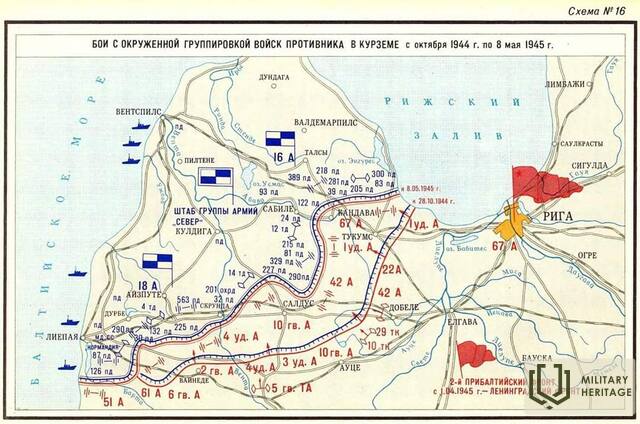

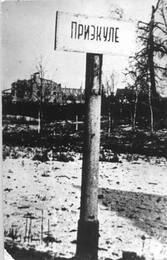
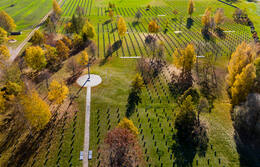
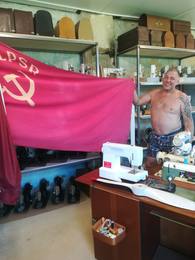
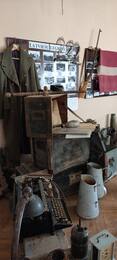
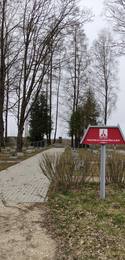
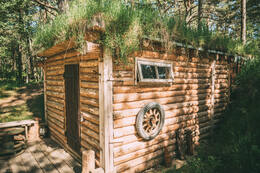
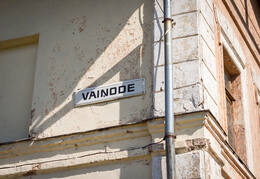
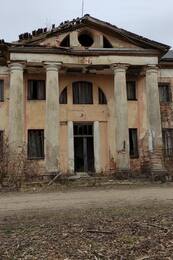
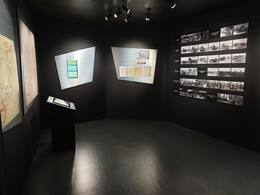
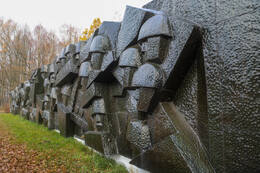

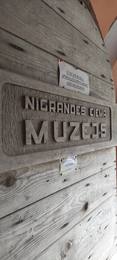


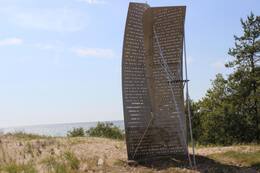
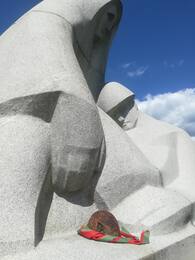
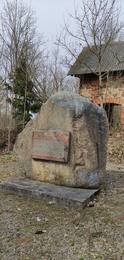

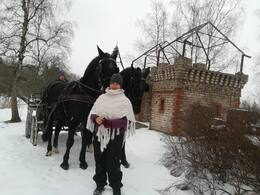
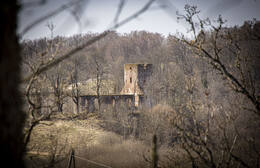
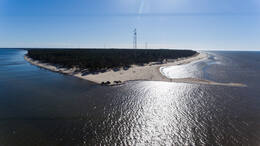
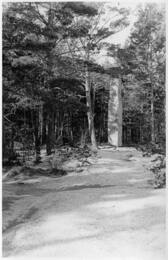
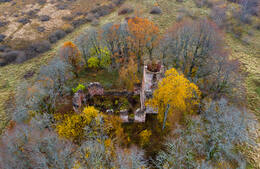
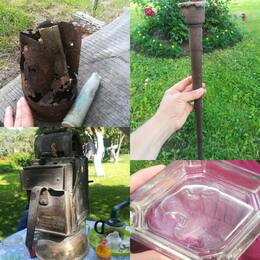
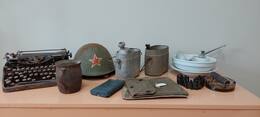
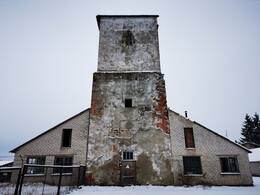


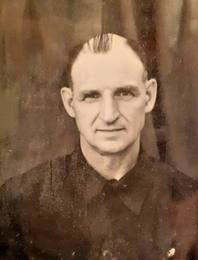
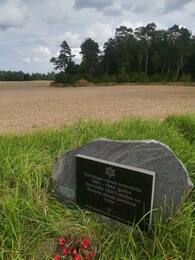

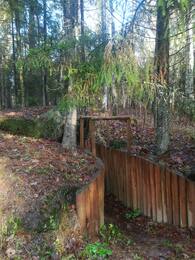
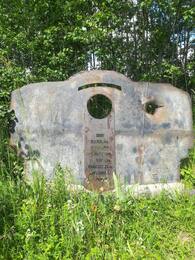

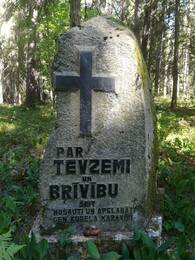
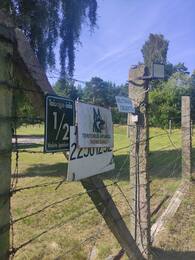
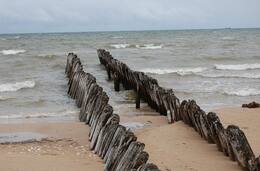
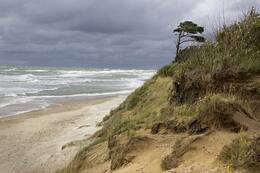
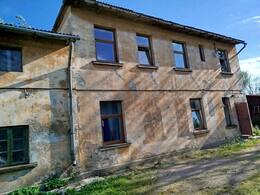
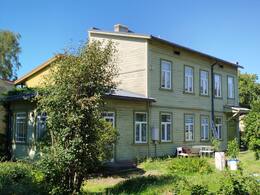
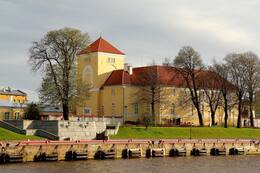

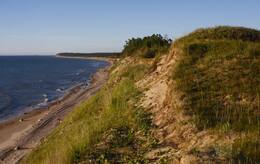
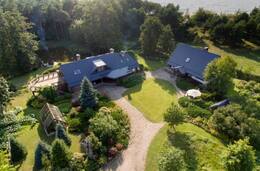
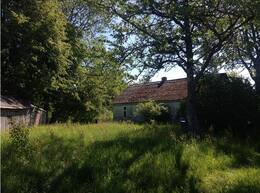
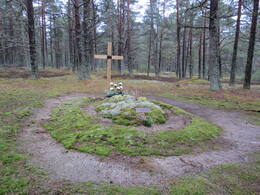

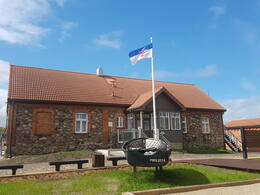
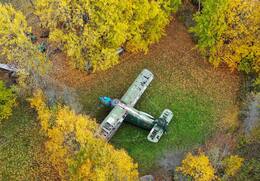
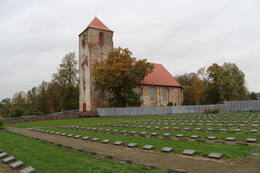
Prašau pataisyti – kariuomenės grupė vadinosi Kurša.